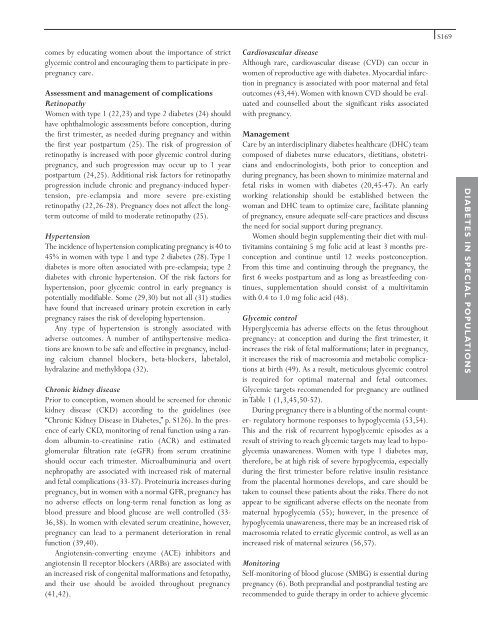2008 Clinical Practice Guidelines - Canadian Diabetes Association
2008 Clinical Practice Guidelines - Canadian Diabetes Association
2008 Clinical Practice Guidelines - Canadian Diabetes Association
Create successful ePaper yourself
Turn your PDF publications into a flip-book with our unique Google optimized e-Paper software.
comes by educating women about the importance of strict<br />
glycemic control and encouraging them to participate in prepregnancy<br />
care.<br />
Assessment and management of complications<br />
Retinopathy<br />
Women with type 1 (22,23) and type 2 diabetes (24) should<br />
have ophthalmologic assessments before conception, during<br />
the first trimester, as needed during pregnancy and within<br />
the first year postpartum (25). The risk of progression of<br />
retinopathy is increased with poor glycemic control during<br />
pregnancy, and such progression may occur up to 1 year<br />
postpartum (24,25). Additional risk factors for retinopathy<br />
progression include chronic and pregnancy-induced hypertension,<br />
pre-eclampsia and more severe pre-existing<br />
retinopathy (22,26-28). Pregnancy does not affect the longterm<br />
outcome of mild to moderate retinopathy (25).<br />
Hypertension<br />
The incidence of hypertension complicating pregnancy is 40 to<br />
45% in women with type 1 and type 2 diabetes (28). Type 1<br />
diabetes is more often associated with pre-eclampsia; type 2<br />
diabetes with chronic hypertension. Of the risk factors for<br />
hypertension, poor glycemic control in early pregnancy is<br />
potentially modifiable. Some (29,30) but not all (31) studies<br />
have found that increased urinary protein excretion in early<br />
pregnancy raises the risk of developing hypertension.<br />
Any type of hypertension is strongly associated with<br />
adverse outcomes. A number of antihypertensive medications<br />
are known to be safe and effective in pregnancy, including<br />
calcium channel blockers, beta-blockers, labetalol,<br />
hydralazine and methyldopa (32).<br />
Chronic kidney disease<br />
Prior to conception, women should be screened for chronic<br />
kidney disease (CKD) according to the guidelines (see<br />
“Chronic Kidney Disease in <strong>Diabetes</strong>,” p. S126). In the presence<br />
of early CKD, monitoring of renal function using a random<br />
albumin-to-creatinine ratio (ACR) and estimated<br />
glomerular filtration rate (eGFR) from serum creatinine<br />
should occur each trimester. Microalbuminuria and overt<br />
nephropathy are associated with increased risk of maternal<br />
and fetal complications (33-37). Proteinuria increases during<br />
pregnancy, but in women with a normal GFR, pregnancy has<br />
no adverse effects on long-term renal function as long as<br />
blood pressure and blood glucose are well controlled (33-<br />
36,38). In women with elevated serum creatinine, however,<br />
pregnancy can lead to a permanent deterioration in renal<br />
function (39,40).<br />
Angiotensin-converting enzyme (ACE) inhibitors and<br />
angiotensin II receptor blockers (ARBs) are associated with<br />
an increased risk of congenital malformations and fetopathy,<br />
and their use should be avoided throughout pregnancy<br />
(41,42).<br />
Cardiovascular disease<br />
Although rare, cardiovascular disease (CVD) can occur in<br />
women of reproductive age with diabetes. Myocardial infarction<br />
in pregnancy is associated with poor maternal and fetal<br />
outcomes (43,44).Women with known CVD should be evaluated<br />
and counselled about the significant risks associated<br />
with pregnancy.<br />
Management<br />
Care by an interdisciplinary diabetes healthcare (DHC) team<br />
composed of diabetes nurse educators, dietitians, obstetricians<br />
and endocrinologists, both prior to conception and<br />
during pregnancy, has been shown to minimize maternal and<br />
fetal risks in women with diabetes (20,45-47). An early<br />
working relationship should be established between the<br />
woman and DHC team to optimize care, facilitate planning<br />
of pregnancy, ensure adequate self-care practices and discuss<br />
the need for social support during pregnancy.<br />
Women should begin supplementing their diet with multivitamins<br />
containing 5 mg folic acid at least 3 months preconception<br />
and continue until 12 weeks postconception.<br />
From this time and continuing through the pregnancy, the<br />
first 6 weeks postpartum and as long as breastfeeding continues,<br />
supplementation should consist of a multivitamin<br />
with 0.4 to 1.0 mg folic acid (48).<br />
Glycemic control<br />
Hyperglycemia has adverse effects on the fetus throughout<br />
pregnancy: at conception and during the first trimester, it<br />
increases the risk of fetal malformations; later in pregnancy,<br />
it increases the risk of macrosomia and metabolic complications<br />
at birth (49). As a result, meticulous glycemic control<br />
is required for optimal maternal and fetal outcomes.<br />
Glycemic targets recommended for pregnancy are outlined<br />
in Table 1 (1,3,45,50-52).<br />
During pregnancy there is a blunting of the normal counter-<br />
regulatory hormone responses to hypoglycemia (53,54).<br />
This and the risk of recurrent hypoglycemic episodes as a<br />
result of striving to reach glycemic targets may lead to hypoglycemia<br />
unawareness. Women with type 1 diabetes may,<br />
therefore, be at high risk of severe hypoglycemia, especially<br />
during the first trimester before relative insulin resistance<br />
from the placental hormones develops, and care should be<br />
taken to counsel these patients about the risks.There do not<br />
appear to be significant adverse effects on the neonate from<br />
maternal hypoglycemia (55); however, in the presence of<br />
hypoglycemia unawareness, there may be an increased risk of<br />
macrosomia related to erratic glycemic control, as well as an<br />
increased risk of maternal seizures (56,57).<br />
Monitoring<br />
Self-monitoring of blood glucose (SMBG) is essential during<br />
pregnancy (6). Both preprandial and postprandial testing are<br />
recommended to guide therapy in order to achieve glycemic<br />
S169<br />
DIABETES IN SPECIAL POPULATIONS











